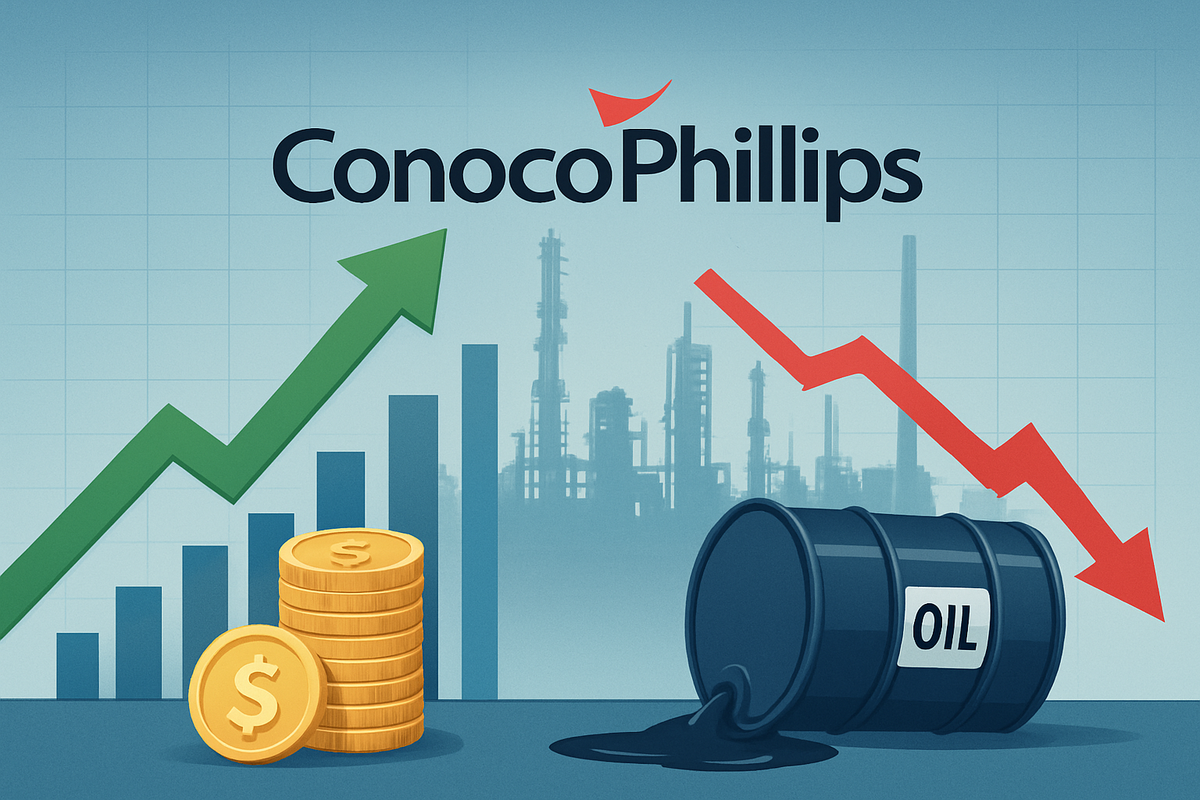
HOUSTON, TX – November 6, 2025 – Two years ago, on November 2, 2023, ConocoPhillips (NYSE: COP), one of the world's largest independent exploration and production (E&P) companies, made headlines with a seemingly counterintuitive announcement. Despite reporting a significant slide in its third-quarter 2023 net income, the company simultaneously declared a robust 14% increase in its quarterly ordinary dividend, raising it to $0.58 per share. This bold move, coming amidst a period of lower global oil prices, highlighted the company's commitment to shareholder returns and its confidence in its long-term financial health, even as immediate profitability faced pressure.
The decision sent a clear message to the market: ConocoPhillips was prioritizing a consistent and growing return to shareholders, leveraging its strong operational performance and strategic capital allocation to weather the volatility inherent in the energy sector. While the immediate financial results reflected the impact of a softer pricing environment, the dividend hike underscored a strategic vision focused on value creation, distinguishing the company's approach during a challenging quarter for the broader oil and gas industry.
Navigating the Q3 2023 Landscape: A Deeper Dive into ConocoPhillips' Performance
ConocoPhillips' third-quarter 2023 financial report, released on November 2, 2023, painted a mixed picture. The company's net income for the quarter stood at $2.8 billion, or $2.32 per share, a notable decrease from the $4.5 billion, or $3.55 per share, reported in the third quarter of 2022. This represented a substantial decline of approximately 37.8% in net income year-over-year. Adjusted earnings, excluding special items, also saw a dip to $2.6 billion, or $2.16 per share, down from $4.6 billion, or $3.60 per share, in the prior-year quarter, though the adjusted EPS did manage to surpass the Zacks Consensus Estimate of $2.04. Revenue for the quarter likewise experienced a significant reduction, coming in at $14.87 billion, missing the consensus estimate of $15.32 billion and falling considerably from the $21.614 billion generated in Q3 2022.
The primary culprit behind these reduced financial figures was unequivocally "lower prices." ConocoPhillips' total average realized price per barrel of oil equivalent (BOE) in Q3 2023 was $60.05, marking a substantial 28% decrease from the $83.07 per BOE realized in the third quarter of 2022. This sharp decline in commodity prices directly impacted the company's top and bottom lines. Despite this headwind, ConocoPhillips' management, led by Chairman and CEO Ryan Lance, emphasized the company's strong operational execution, highlighting record production for the third consecutive quarter. This increased production volume played a crucial role in partially offsetting the adverse effects of lower realized prices, contributing to better-than-expected adjusted earnings. Lance underscored the dividend increase as "consistent with our long-term objective to deliver top quartile growth relative to the S&P 500," reinforcing the company's commitment to its "returns-focused value proposition."
The announcement was met with keen interest from investors and analysts. While the decline in net income was a clear reflection of market conditions, the dividend increase signaled management's confidence in the underlying strength of its assets and future cash flow generation capabilities. For shareholders, it reaffirmed ConocoPhillips' dedication to returning capital, a strategy often favored by mature energy companies, particularly during periods of market uncertainty. The company's strategic acquisition of the remaining 50% interest in Surmont, which led to raised full-year guidance, further bolstered this sentiment, indicating a proactive approach to portfolio optimization and growth despite the challenging price environment.
Market Ripple Effects: Winners and Losers in a Volatile Energy Landscape
The situation faced by ConocoPhillips (NYSE: COP) in late 2023 was emblematic of the broader challenges and opportunities within the exploration and production (E&P) sector. Companies with robust balance sheets, diversified asset portfolios, and efficient operational structures were better positioned to navigate the volatility. For instance, larger integrated oil companies like ExxonMobil (NYSE: XOM) and Chevron (NYSE: CVX), with their downstream refining and chemical operations, often have a natural hedge against fluctuating crude prices, as lower input costs can boost refining margins. However, pure-play E&P companies like ConocoPhillips rely more directly on commodity prices.
In this environment, companies that had aggressively hedged their production at higher prices or possessed lower lifting costs per barrel would have been relative "winners," maintaining stronger cash flows. Conversely, smaller, highly leveraged E&P firms with less diversified asset bases and higher operational expenses would have been "losers," facing increased financial strain, potential debt covenant breaches, and diminished access to capital markets. Service providers to the oil and gas industry, such as Schlumberger (NYSE: SLB) or Halliburton (NYSE: HAL), would also have felt the ripple effects, as E&P companies might defer or reduce capital expenditures in response to lower commodity prices, impacting demand for drilling, completion, and well maintenance services.
For ConocoPhillips, its scale, global footprint, and disciplined capital allocation strategy allowed it to maintain shareholder returns even as profits dipped. This resilience highlighted the competitive advantage of major players over smaller, less diversified counterparts who might have struggled to maintain dividends or even operational solvency under similar pressures. The event underscored a growing bifurcation in the E&P market, where financial strength and strategic flexibility became paramount for sustained success.
Broader Significance: Adapting to the Evolving Energy Paradigm
ConocoPhillips' Q3 2023 performance and dividend strategy provided a snapshot of the energy industry's ongoing adaptation to a dynamic global landscape. The decline in oil prices during that period was influenced by a confluence of factors, including concerns about global economic slowdowns, persistent inflation, and the lingering effects of geopolitical tensions. This volatility underscored the inherent cyclicality of the commodity market, a trend that has continued to define the sector well into 2025.
The event also highlighted the broader industry trend of E&P companies balancing capital discipline with shareholder returns. Post-2020, many producers pivoted from a growth-at-all-costs mentality to a focus on free cash flow generation and returning capital to shareholders through dividends and share buybacks. ConocoPhillips' dividend increase, despite lower net income, was a strong affirmation of this strategic shift, signaling a mature industry prioritizing stability and investor loyalty over aggressive expansion in a volatile pricing environment. This approach has influenced competitors, prompting many to re-evaluate their own capital allocation frameworks to ensure they remain competitive in attracting and retaining investment.
Regulatory and policy implications during that time, and continuing into 2025, largely revolved around the accelerating energy transition. While traditional oil and gas companies like ConocoPhillips continue to be critical for global energy supply, increasing pressure from governments, environmental groups, and investors to decarbonize operations and invest in lower-carbon solutions has become a significant factor. The ability of companies to manage these dual demands—supplying conventional energy while preparing for a lower-carbon future—is a defining challenge. Historically, the industry has faced numerous boom-and-bust cycles, with companies like ConocoPhillips often emerging stronger through strategic consolidations, technological advancements, and a focus on operational efficiency during downturns. The 2023 dividend decision can be seen as another instance of a major player leveraging its financial fortitude to navigate a challenging phase.
What Comes Next: Navigating 2025 and Beyond
Looking forward from the vantage point of November 2025, the strategic decisions made by ConocoPhillips (NYSE: COP) in late 2023 have largely shaped its trajectory. The commitment to a growing dividend, even amidst short-term profit declines, appears to have paid off in terms of investor confidence and stability. In the short term following the 2023 announcement, the market likely rewarded the company for its clear capital allocation policy, providing a degree of insulation from the immediate commodity price fluctuations. This stability would have been particularly attractive to income-focused investors.
For ConocoPhillips, the period between 2023 and 2025 has likely involved a continued focus on optimizing its asset base, enhancing operational efficiencies, and selectively pursuing high-return projects. The emphasis on record production, as noted by CEO Ryan Lance in 2023, suggests a strategy of maximizing output from existing, lower-cost assets to generate consistent cash flow. Potential strategic pivots might have included further divestments of non-core assets, increased investment in natural gas projects (given its role in the energy transition), or even modest ventures into carbon capture, utilization, and storage (CCUS) technologies to align with evolving environmental standards.
Market opportunities emerging since then would likely include periods of oil price recovery, allowing the company to capitalize on its efficient production. Challenges would persist in the form of continued geopolitical instability affecting supply, the ongoing pressure for decarbonization, and the need to manage capital expenditures carefully to avoid oversupply. Scenarios for ConocoPhillips in late 2025 could range from sustained strong performance if oil demand remains robust and prices stabilize at favorable levels, to continued pressure if global economic growth falters or if the pace of renewable energy adoption significantly outstrips expectations for fossil fuel demand. The company's ability to adapt its portfolio and maintain its "returns-focused value proposition" will remain critical.
Comprehensive Wrap-Up: A Resilient Path Forward
ConocoPhillips' decision in November 2023 to increase its dividend despite a significant downturn in net income due to lower oil prices serves as a compelling case study in corporate resilience and strategic foresight within the volatile energy sector. The key takeaway is that for a company with a strong financial foundation and a clear commitment to shareholder returns, short-term market headwinds do not necessarily dictate long-term capital allocation strategy. Instead, the move underscored a confidence in the company's operational capabilities and its ability to generate sustainable cash flow even in challenging environments.
Moving forward into 2025, the market continues to grapple with the inherent unpredictability of global energy markets, influenced by geopolitical events, macroeconomic trends, and the accelerating energy transition. ConocoPhillips' proactive stance in 2023 likely positioned it as a stable investment choice for those seeking consistent income from the energy sector. Its emphasis on operational excellence and disciplined capital management has become a blueprint for navigating a landscape where profitability can fluctuate wildly.
Investors in the coming months should continue to watch for several key indicators: the trajectory of global oil and gas prices, ConocoPhillips' ongoing production volumes and cost efficiencies, further updates on its capital allocation strategy (including any changes to its variable return of cash framework), and its advancements in lower-carbon initiatives. The lasting impact of the 2023 dividend decision is its reinforcement of ConocoPhillips' identity as a reliable dividend payer, a critical attribute in an industry often characterized by its boom-and-bust cycles. This strategy has likely helped the company maintain a strong investor base and navigate the complexities of the mid-2020s energy market with a degree of stability.
This content is intended for informational purposes only and is not financial advice







